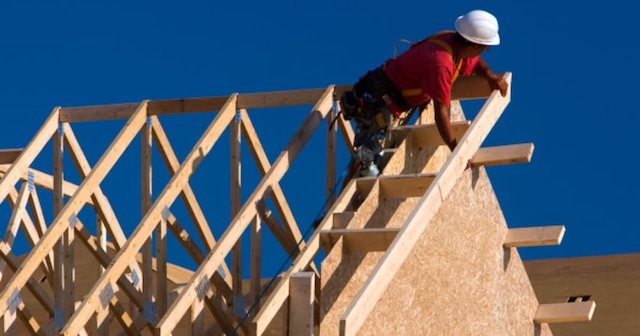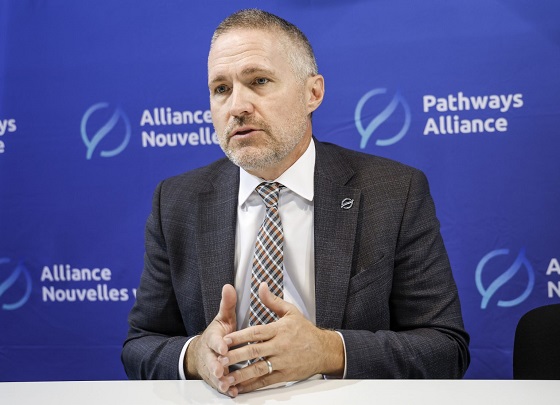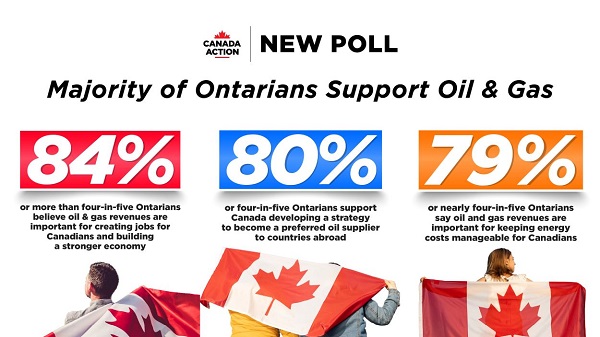Alberta
New red tape reporting website will help ramp up housing construction in Alberta

Helping builders by putting an end to housing delays
Alberta’s new Stop Housing Delays online portal will allow developers, municipalities and other housing partners to report red tape and unnecessary home-building delays.
Alberta’s government is focused on ensuring Albertans have access to the housing they need, and that means working to streamline processes, cut red tape and reduce delays that are slowing housing construction down. As part of this work, government has launched a new online portal to help in these efforts.
The Stop Housing Delays online portal is now available for developers and municipal authorities to help identify areas that are preventing fast and efficient residential construction. This portal will help government identify and address barriers to building homes across the province.
“The Stop Housing Delays portal will allow Alberta’s government to hear directly from developers, municipalities and other partners on where delays are happening in the construction process. This will help identify and remove barriers, ultimately getting homes built faster and continuing Alberta’s record home-building pace.”
“Alberta’s government will continue to work with municipalities and find solutions to speed up the home-building process. The Stop Housing Delays portal will give us another tool to inform those discussions and identify areas where we can improve the pace of home building.”
Once developers, municipalities or industry partners have submitted their issue using the online form, government will collect and assess the information provided. Alberta’s government will be taking a collaborative, cross-ministry approach to ensure the appropriate departments are working together to find solutions where possible. Solutions may range from minor changes to policy reform.
Alberta’s government continues to support builders and encourage new residential housing construction by reducing red tape, incentivizing housing construction and supporting innovative strategies to build homes faster than ever.
“This webpage is an excellent opportunity to gather knowledge and further eliminate red tape. Government has been persistent in our approach of cutting red tape and removing roadblocks, and this will help to speed up residential construction. I look forward to hearing from developers and our other partners on how we can help get projects moving and Albertans in homes.”
Alberta continues to see strong housing starts and increases while other provinces across Canada are seeing a reduction in housing starts. The first half of 2024 saw 9,903 apartment unit starts in the province. This marks the highest amount in any half year in Alberta’s history, breaking the previous record of 9,750 set in 1977. Albertans will benefit from 33,577 new housing starts from January through September 2024, up 35 per cent from the same period last year. Alberta’s government remains focused on working with industry and non-profit partners to ensure that the province’s growing population has access to the housing it needs.
“This portal is a valuable tool for industry to highlight gaps, barriers and delays that may need to be prioritized and addressed by either local or provincial governments. Real solutions can only emerge through transparency, open communication and collaboration. This is an important step toward identifying the unique challenges each region and municipality faces in delivering attainable housing.”
Quick Facts
- Housing starts for January – September 2024 compared with January – September 2023
- Provincewide: 33,577 compared with 24,904 (up 35 per cent)
- Edmonton: 13,359 compared with 9,099 (up 47 per cent)
- Calgary: 17,414 compared with 14,141 (up 23 per cent)
- Lethbridge: 599 compared with 148 (up 305 per cent)
- Red Deer: 314 compared with 146 (up 115 per cent)
- Data shows Alberta had 10,699 purpose-built rentals, making up 32 per cent of all housing starts.
- Since 2019, Alberta’s government has invested almost $850 million to build more than 5,100 units and close to 900 shelter spaces. This includes projects we have committed to, that are in progress and that are complete.
- Together with its partners, Alberta’s government is supporting $9 billion in investments into affordable housing to support 25,000 additional low-income households by 2031.
Related information
Alberta
Alberta project would be “the biggest carbon capture and storage project in the world”

Pathways Alliance CEO Kendall Dilling is interviewed at the World Petroleum Congress in Calgary, Monday, Sept. 18, 2023.THE CANADIAN PRESS/Jeff McIntosh
From Resource Works
Carbon capture gives biggest bang for carbon tax buck CCS much cheaper than fuel switching: report
Canada’s climate change strategy is now joined at the hip to a pipeline. Two pipelines, actually — one for oil, one for carbon dioxide.
The MOU signed between Ottawa and Alberta two weeks ago ties a new oil pipeline to the Pathways Alliance, which includes what has been billed as the largest carbon capture proposal in the world.
One cannot proceed without the other. It’s quite possible neither will proceed.
The timing for multi-billion dollar carbon capture projects in general may be off, given the retreat we are now seeing from industry and government on decarbonization, especially in the U.S., our biggest energy customer and competitor.
But if the public, industry and our governments still think getting Canada’s GHG emissions down is a priority, decarbonizing Alberta oil, gas and heavy industry through CCS promises to be the most cost-effective technology approach.
New modelling by Clean Prosperity, a climate policy organization, finds large-scale carbon capture gets the biggest bang for the carbon tax buck.
Which makes sense. If oil and gas production in Alberta is Canada’s single largest emitter of CO2 and methane, it stands to reason that methane abatement and sequestering CO2 from oil and gas production is where the biggest gains are to be had.
A number of CCS projects are already in operation in Alberta, including Shell’s Quest project, which captures about 1 million tonnes of CO2 annually from the Scotford upgrader.
What is CO2 worth?
Clean Prosperity estimates industrial carbon pricing of $130 to $150 per tonne in Alberta and CCS could result in $90 billion in investment and 70 megatons (MT) annually of GHG abatement or sequestration. The lion’s share of that would come from CCS.
To put that in perspective, 70 MT is 10% of Canada’s total GHG emissions (694 MT).
The report cautions that these estimates are “hypothetical” and gives no timelines.
All of the main policy tools recommended by Clean Prosperity to achieve these GHG reductions are contained in the Ottawa-Alberta MOU.
One important policy in the MOU includes enhanced oil recovery (EOR), in which CO2 is injected into older conventional oil wells to increase output. While this increases oil production, it also sequesters large amounts of CO2.
Under Trudeau era policies, EOR was excluded from federal CCS tax credits. The MOU extends credits and other incentives to EOR, which improves the value proposition for carbon capture.
Under the MOU, Alberta agrees to raise its industrial carbon pricing from the current $95 per tonne to a minimum of $130 per tonne under its TIER system (Technology Innovation and Emission Reduction).
The biggest bang for the buck
Using a price of $130 to $150 per tonne, Clean Prosperity looked at two main pathways to GHG reductions: fuel switching in the power sector and CCS.
Fuel switching would involve replacing natural gas power generation with renewables, nuclear power, renewable natural gas or hydrogen.
“We calculated that fuel switching is more expensive,” Brendan Frank, director of policy and strategy for Clean Prosperity, told me.
Achieving the same GHG reductions through fuel switching would require industrial carbon prices of $300 to $1,000 per tonne, Frank said.
Clean Prosperity looked at five big sectoral emitters: oil and gas extraction, chemical manufacturing, pipeline transportation, petroleum refining, and cement manufacturing.
“We find that CCUS represents the largest opportunity for meaningful, cost-effective emissions reductions across five sectors,” the report states.

Fuel switching requires higher carbon prices than CCUS.
Measures like energy efficiency and methane abatement are included in Clean Prosperity’s calculations, but again CCS takes the biggest bite out of Alberta’s GHGs.
“Efficiency and (methane) abatement are a portion of it, but it’s a fairly small slice,” Frank said. “The overwhelming majority of it is in carbon capture.”

From left, Alberta Minister of Energy Marg McCuaig-Boyd, Shell Canada President Lorraine Mitchelmore, CEO of Royal Dutch Shell Ben van Beurden, Marathon Oil Executive Brian Maynard, Shell ER Manager, Stephen Velthuizen, and British High Commissioner to Canada Howard Drake open the valve to the Quest carbon capture and storage facility in Fort Saskatchewan Alta, on Friday November 6, 2015. Quest is designed to capture and safely store more than one million tonnes of CO2 each year an equivalent to the emissions from about 250,000 cars. THE CANADIAN PRESS/Jason Franson
Credit where credit is due
Setting an industrial carbon price is one thing. Putting it into effect through a workable carbon credit market is another.
“A high headline price is meaningless without higher credit prices,” the report states.
“TIER credit prices have declined steadily since 2023 and traded below $20 per tonne as of November 2025. With credit prices this low, the $95 per tonne headline price has a negligible effect on investment decisions and carbon markets will not drive CCUS deployment or fuel switching.”
Clean Prosperity recommends a kind of government-backstopped insurance mechanism guaranteeing carbon credit prices, which could otherwise be vulnerable to political and market vagaries.
Specifically, it recommends carbon contracts for difference (CCfD).
“A straight-forward way to think about it is insurance,” Frank explains.
Carbon credit prices are vulnerable to risks, including “stroke-of-pen risks,” in which governments change or cancel price schedules. There are also market risks.
CCfDs are contractual agreements between the private sector and government that guarantees a specific credit value over a specified time period.
“The private actor basically has insurance that the credits they’ll generate, as a result of making whatever low-carbon investment they’re after, will get a certain amount of revenue,” Frank said. “That certainty is enough to, in our view, unlock a lot of these projects.”
From the perspective of Canadian CCS equipment manufacturers like Vancouver’s Svante, there is one policy piece still missing from the MOU: eligibility for the Clean Technology Manufacturing (CTM) Investment tax credit.
“Carbon capture was left out of that,” said Svante co-founder Brett Henkel said.
Svante recently built a major manufacturing plant in Burnaby for its carbon capture filters and machines, with many of its prospective customers expected to be in the U.S.
The $20 billion Pathways project could be a huge boon for Canadian companies like Svante and Calgary’s Entropy. But there is fear Canadian CCS equipment manufacturers could be shut out of the project.
“If the oil sands companies put out for a bid all this equipment that’s needed, it is highly likely that a lot of that equipment is sourced outside of Canada, because the support for Canadian manufacturing is not there,” Henkel said.
Henkel hopes to see CCS manufacturing added to the eligibility for the CTM investment tax credit.
“To really build this eco-system in Canada and to support the Pathways Alliance project, we need that amendment to happen.”
Resource Works News
Alberta
Alberta Next Panel calls for less Ottawa—and it could pay off

From the Fraser Institute
By Tegan Hill
Last Friday, less than a week before Christmas, the Smith government quietly released the final report from its Alberta Next Panel, which assessed Alberta’s role in Canada. Among other things, the panel recommends that the federal government transfer some of its tax revenue to provincial governments so they can assume more control over the delivery of provincial services. Based on Canada’s experience in the 1990s, this plan could deliver real benefits for Albertans and all Canadians.
Federations such as Canada typically work best when governments stick to their constitutional lanes. Indeed, one of the benefits of being a federalist country is that different levels of government assume responsibility for programs they’re best suited to deliver. For example, it’s logical that the federal government handle national defence, while provincial governments are typically best positioned to understand and address the unique health-care and education needs of their citizens.
But there’s currently a mismatch between the share of taxes the provinces collect and the cost of delivering provincial responsibilities (e.g. health care, education, childcare, and social services). As such, Ottawa uses transfers—including the Canada Health Transfer (CHT)—to financially support the provinces in their areas of responsibility. But these funds come with conditions.
Consider health care. To receive CHT payments from Ottawa, provinces must abide by the Canada Health Act, which effectively prevents the provinces from experimenting with new ways of delivering and financing health care—including policies that are successful in other universal health-care countries. Given Canada’s health-care system is one of the developed world’s most expensive universal systems, yet Canadians face some of the longest wait times for physicians and worst access to medical technology (e.g. MRIs) and hospital beds, these restrictions limit badly needed innovation and hurt patients.
To give the provinces more flexibility, the Alberta Next Panel suggests the federal government shift tax points (and transfer GST) to the provinces to better align provincial revenues with provincial responsibilities while eliminating “strings” attached to such federal transfers. In other words, Ottawa would transfer a portion of its tax revenues from the federal income tax and federal sales tax to the provincial government so they have funds to experiment with what works best for their citizens, without conditions on how that money can be used.
According to the Alberta Next Panel poll, at least in Alberta, a majority of citizens support this type of provincial autonomy in delivering provincial programs—and again, it’s paid off before.
In the 1990s, amid a fiscal crisis (greater in scale, but not dissimilar to the one Ottawa faces today), the federal government reduced welfare and social assistance transfers to the provinces while simultaneously removing most of the “strings” attached to these dollars. These reforms allowed the provinces to introduce work incentives, for example, which would have previously triggered a reduction in federal transfers. The change to federal transfers sparked a wave of reforms as the provinces experimented with new ways to improve their welfare programs, and ultimately led to significant innovation that reduced welfare dependency from a high of 3.1 million in 1994 to a low of 1.6 million in 2008, while also reducing government spending on social assistance.
The Smith government’s Alberta Next Panel wants the federal government to transfer some of its tax revenues to the provinces and reduce restrictions on provincial program delivery. As Canada’s experience in the 1990s shows, this could spur real innovation that ultimately improves services for Albertans and all Canadians.
-

 armed forces1 day ago
armed forces1 day agoRemembering Afghanistan and the sacrifices of our military families
-

 Fraser Institute1 day ago
Fraser Institute1 day agoHow to talk about housing at the holiday dinner table
-

 Frontier Centre for Public Policy1 day ago
Frontier Centre for Public Policy1 day agoTent Cities Were Rare Five Years Ago. Now They’re Everywhere
-

 Opinion1 day ago
Opinion1 day agoPope Leo XIV’s Christmas night homily
-

 Fraser Institute19 hours ago
Fraser Institute19 hours agoCarney government sowing seeds for corruption in Ottawa
-

 Alberta19 hours ago
Alberta19 hours agoAlberta Next Panel calls for less Ottawa—and it could pay off
-

 Alberta10 hours ago
Alberta10 hours agoAlberta project would be “the biggest carbon capture and storage project in the world”
-

 Energy10 hours ago
Energy10 hours agoNew Poll Shows Ontarians See Oil & Gas as Key to Jobs, Economy, and Trade










